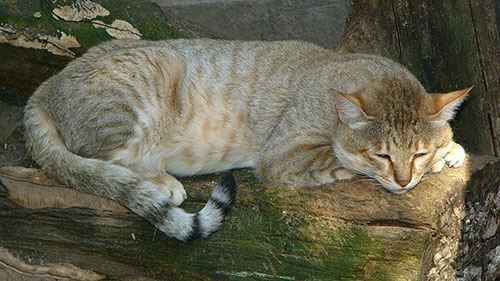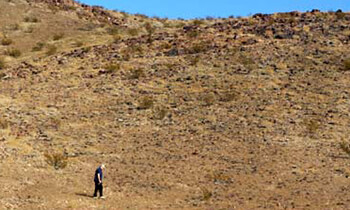Arabian Wildcat
(Felis silvestris gordoni)
by Jay W. Sharp

'Felis silvestris gordoni'' in Zoo Olomouc, the Czech Republic. Photo by Michal Maňas, 2006
The Arabian (or Gordon's) wildcat may look like a big ole' tabby cat, but, pound for pound, this animal -- powerful, supple and fiercely combative -- is a formidable predator, usually striking in the darkness of night to take its quarry.
Characteristics of the Arabian Wildcat
Like all felines, the Arabian wildcat -- comparable in size and anatomy to the typical house cat -- is superbly designed for stalking, capturing and killing its prey.
- Size and Weight: Finely muscled, the cat typically weighs 6 to 18 pounds; its head and tail measure some 20 to 29 inches in length; and its tail, as much as 8 to 14 inches. It stands roughly 12 inches high at the shoulder.
- Coat and Color: Short, thick, grayish brown fur covers most of its body, and it is camouflaged with black bands across its face and back. The cat has white patches on its throat, between its forelegs and on its belly. It has black bands around its legs and three black bands around the tip of its tail. Its paws have fine black hairs between the black pads.
- Head and Face: The animal's face, often striped, has a white mouth, grayish green eyes, and large rust-colored and black-tipped ears. Its teeth, which include pointed canines, sharp molars and small incisors, are designed for seizing and killing its prey and for ripping and tearing the flesh. Its tongue has thousands of tiny rough sandpaper-like mounds on the surface to facilitate licking and self grooming. Its mouth, at the top, has a Jacobson's Organ. This enhances its sense of smell, particularly of pheromones, helping it to communicate with other Arabian wildcats. Thick facial hairs, called "whiskers," help the cat "feel" its location and proximate objects in tight dark quarters.
- Body and Legs: The cat's body and legs create a synthesis of stealth, agility, quickness and grace. Its muscular rear legs and haunches give it surprising facility for springing. Its sharp, hooked claws, which are retractable, help it to catch, clasp and kill prey, and to fight off rivals.
- Senses: The cat has sharp senses of smell, hearing and vision. Aided by its Jacobson's Organ, the cat's sense of smell is several times more sensitive than a human's, helping it detect prey, a potential mate, a possible enemy and territorial boundaries. Large ears help its sense of hearing to detect a much broader range of frequencies of sound than most other mammals', assisting it in locating prey such as rodents that emit ultrasonic calls. Thanks to large, slit pupils, the cat's sense of vision allows it to see clearly in light too dim for human eyes, helping make possible its nocturnal lifestyle.
- Communication: Unlike the large cats, the Arabian wildcat (as well as other species of the small wildcats) does not roar. Much like a domestic cat, it hisses, growls, purrs or meows (a harsh-sounding "mwa, mwa"), usually to communicate its mood to a nearby cat. A female may squeak to silence her kittens. The cat advertises its territory by spraying urine and depositing scat throughout its range. It uses body language, arching its back and raising its hair to warn an enemy. A female uses a specialized gland to produce a scent that signals her readiness to mate.
Distribution, Habitat and Diet
The genetically pure Arabian wildcat now occurs only in the United Arab Emirates and northern Oman, in the eastern Arabian Peninsula. It makes its home in semi-desert and rocky terrain, avoiding the desert wastelands filled with large dunes that lack scrub and rock.
It establishes a territory that may span several square miles, with a male occupying a larger territory than a female. The territory of a male may overlap the territories of several females. The cat may range over 8 to 10 miles in the course of a year.
Typically, the cat maintains several den sites within its territory, assuring a safe haven exists close by, wherever it may be. It usually builds a den with a single entrance on the slope of a dune.
It preys primarily on rodents, reptiles, small birds and even insects, although it will occasionally eat small amounts of vegetable matter. It depends on the liquids in its diet to meet most of its needs for water.
Behavior and Life Cycle
A solitary animal, the Arabian wildcat seeks companionship, specifically a mate, only during the breeding season in the cooler months of November through January. The male is drawn by the scent of a female, who will remain sexually receptive for only a few days. After mating, the male resumes his lonely life. He will take no part in rearing the young.
Meanwhile, the female prepares a den for her coming brood. Some 65 days or so after mating, she delivers 3 or 4 blind and helpless kittens, each bearing a spotted coat and weighing about 3 to 5 ounces.
A kitten, opening its eyes about 7 to 12 days after its birth, nurses for several weeks. As it grows, the spots of its coat merge into stripes. Fully weaned at about 2 to 3 months, it follows its mother to learn the art of hunting live prey. Growing rapidly, the kittens become self-reliant at about six months, and mature sexually at about one year. In the wild, the Arabian wildcat may live for about 7 to 8 years. In captivity, it may live for twice that long.
Perils
As a species, the Arabian wildcat has benefited from the preservation work of environmental organizations such as the Arabian Leopard Trust. Nevertheless, the cat faces long-term threats to its existence. Its range has been adversely affected by encroachment from human expansion. Its numbers have been impacted by road kills and hunting. It cross-breeds readily with encroaching humans' pet and feral cats, raising the specters of pervasive hybridization and disease transmission. Cross-breeding could lead to the extinction of the pure species.
Interesting Facts
- The modern housecat likely descended from self-domesticating wildcats, which made themselves at home near the earliest farmers' storage granaries, preying on the rodents.
- The cat's ferocity is well noted by tribesmen, who say, "they would rather tackle a wild leopard than a Gordon's [Arabian] wildcat."1
- The Arabian wildcat may be somewhat protected in Islamic society because the Prophet Mohammed is said to have loved them. According to one legend, he cut off the sleeve of his coat rather than disturb a cat sleeping on it.
Sources:
The Emirates: A Natural History, Edited by Peter Hellyer and Simon Aspinall, Trident Press, 2005.
"Range size and den use of Gordon's wildcats Felis silvestris gordoni in the emirate of Sharjah, United Arab Emirates," P. Phelan and A. Sliwa.
Utah's Hogle Zoo
"The Cat in Ancient and Modern Egypt," Rosicrucian Egyptian Museum.
1"Wild Cats, " Zac Sharpe, Al Shindagah, July 1999.
Share this page on Facebook:
The Desert Environment
The North American Deserts
Desert Geological Terms







